
- •Velocity (V) is the distance moved per second in a fixed direction.
- •A. Airborne Sound
- •B. Structure Borne Sound
- •Acoustical defects
- •Room acoustic
- •Shaping an auditorium to improve the path of sound from source to audience.
- •Hall Shapes
- •Noise control
- •Sound absorption is the prevention of reflection of sound or alternatively, a reduction in the sound energy reflected by the surfaces of a room.
- •Sound insulation is the prevention of transmission of sound or alternatively, a reduction of sound energy transmitted into an adjoining air space.
- •Sound Insulation
- •Calculation
- •Tutorial questions:
ROOM ACOUSTICS
PRINCIPLES OF SOUND
Sources and Sound
Sound is an energy which is generated by a source and transmitted through a medium.
Sound travels approximately 340 meters per second.
Sound in the air can cause by vibration of moving object and moving air.
The vibrations of sound move forward using wave motion.
The sound wave can travels through solids, liquids and gases but not in vacuum.
Sound waves can be specified in terms of frequency, wavelength and velocity.
Frequency
Frequency (f) is the rate of vibration, determining how high or low
the pitch is. Frequency (f) is the number of cycles of vibration per
second. Unit:
hertz (Hz)
W
Wavelength (
Unit: metre (m)
Wave Length = Speed of Sound
Frequency
= v
f
Where
= wavelength in m
v = velocity in m/s
f = frequency in Hz
![]() )
is the distance of sound travels in one cycle.
)
is the distance of sound travels in one cycle.
Velocity
Unit: metres per second (m/s)
Therefore the speed at which sound is transmitted,
Velocity (Speed of sound) = frequency x wavelength
v = f
Velocity (V) is the distance moved per second in a fixed direction.
Cancellation of sound
If a wave vibration in one direction meets an equal and opposite vibration, the effect is cancelling of sound.
Velocity of sound
A sound wave travels away from its source with a speed of 344m/s when measured in dry air at 20°C.
The speed of sound is not affected by the frequency of a sound or atmospheric pressure (weather).
The velocity of sound is affected by the properties of the material through which it is travelling.
The velocity of sound in gases decreases with increasing density as the molecules are heavier.
Moist air contains a greater number of light molecules and therefore sound travels slightly faster in moist humid air.
In solid and liquid the particles are much closer together and can transmit the energy from one another more rapidly than air/gas. For example, sound travels through steel about 14 times faster than air.
Frequency of sound
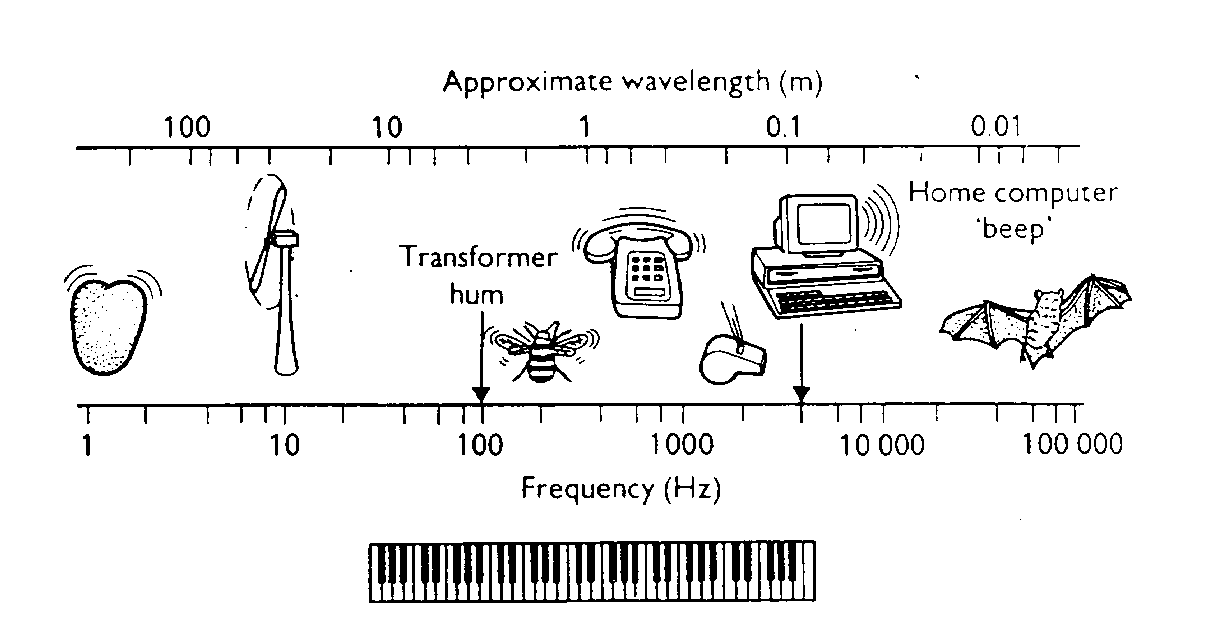
If an object produces sound waves vibrates 100 times in a second then the frequency of that sound wave will be 100Hz.
The human ear hears this as sound of a certain pitch.
Pitch is the frequency of a sound as perceived by human hearing.
Low-pitched notes are caused by low frequency sound waves and high-pitched notes are caused y high-frequency waves.
Resonance
All objects have a natural frequency at which they like to vibrate. For example, the sound of a metal bar dropped on the floor can be distinguished from a block of wood dropped in the same way.
The natural frequency depends upon factors such the shape, density and stiffness of the object.
Resonance occurs when the natural frequency of an object matches with the frequency of any vibrations applied to the object. The result of resonance is extra large vibrations at this frequency.
Sound Intensity
The amount of sound energy that is transferred in a given time over certain area is called the intensity of sound.
The energy is measured for 1s through an area of 1m2.
Unit: Watt per square meter (W/m2) or Joule.
1 Watt = 1 J/s
ACOUSTIC PRINCIPLES
The general requirements for good acoustics for a particular room are:
i. Adequate levels of sound.
ii. Even distribution to all listeners in the room.
iii. Rate of decay (reverberation time) suitable for the type of room.
iv. Background noise and external noise reduced to acceptable levels.
v. Absence of echoes and similar acoustics defects.
Sound paths in rooms
A sound path or sound ray is the direction of the wave vibrations as they travel through a material such as air.
The behaviour of sound paths inside an enclosed space can be affected by the:
Reflection
Absorption
Diffraction
Transmission
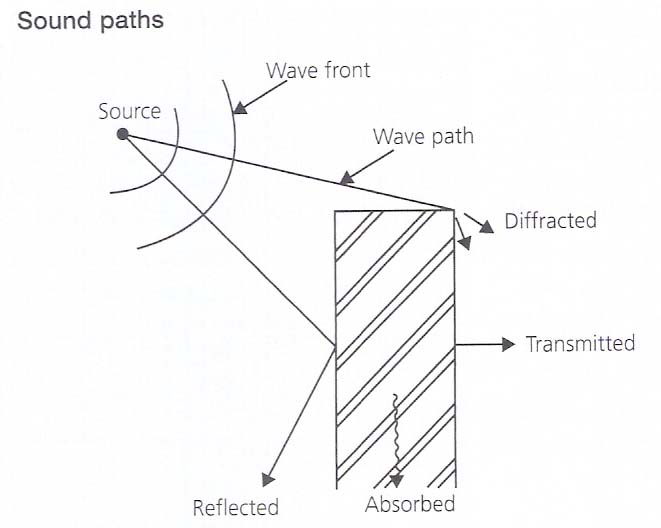
A. Sound Reflection
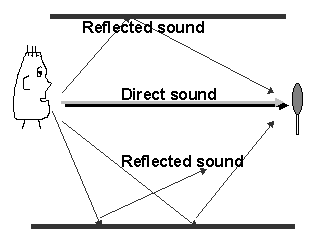
Reflected sound is produced by the direct sound bouncing off the walls, floor etc.
The sound loses some energy at each reflection, depending on the nature of the surface.
Interiors that contains a lot of hard surfaces such as glass, stone, metal are said to be "live" because their high reflectivity.
Soft or porous materials like carpeting, draperies and upholstered furniture, are sound deadening.
There are two types of reflection from room surfaces:
a. Concave surfaces tend to focus sound.
b. Convex surfaces tend to disperse sound.
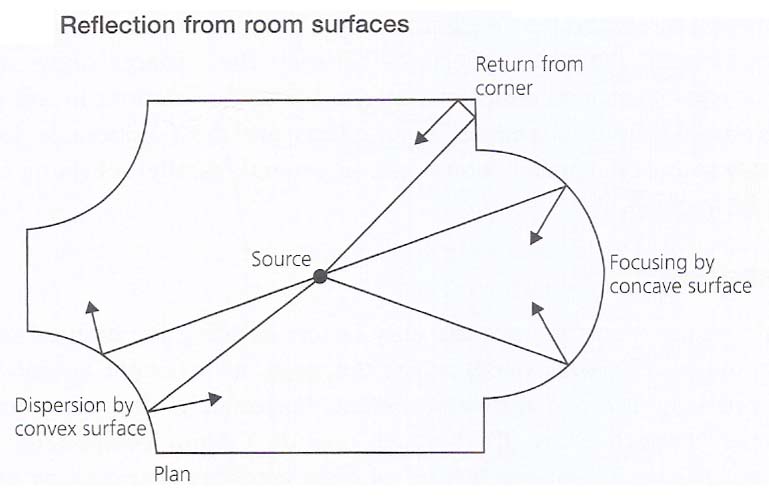
B. Sound Absorption
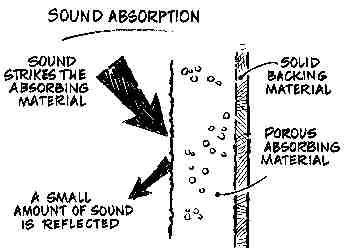
Sound absorption is a reduction in the sound energy reflected from a surface.
Sound absorption is a major factor in producing good room acoustics when controlling reverberation.
The absorption coefficient is a measure of the amount of sound absorption provided by a particular type of surface.
The amount of sound energy not reflected is compared with the amount of sound energy arriving at the surface.
Absorption coefficient (a) = Absorbed sound energy
Incident sound energy
Unit: none – its value expressed in a ratio.
For example, a surface that absorbs 40% of incident sound energy has absorption of 0.4.
The absorption coefficients of a surface depends on:
Type of building materials
Frequency of the incident sound
The effective absorption of a particular surface depends on:
The absorption coefficient of the surface material
The area of that particular surface exposed to the sound.
Absorption of surface = Area of surface x Absorption coefficient of that surface
Unit: m2 sabin
C. Sound Diffraction
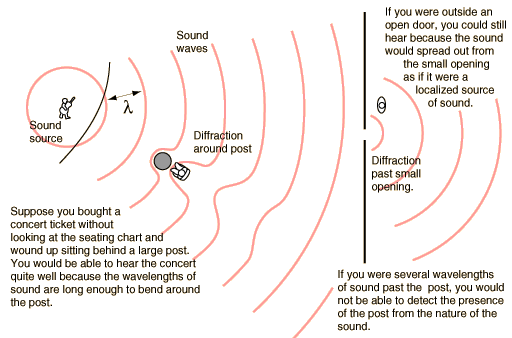
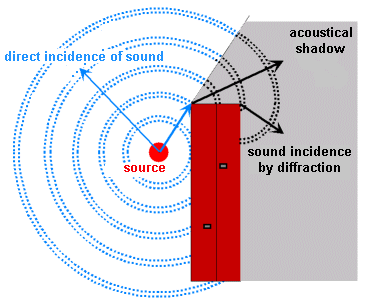
The acoustical phenomenon which causes sound waves to be bent or scattered around obstacles such as corners, columns, walls, beams is called sound diffraction.
In general, diffraction means sound is interrupted by an obstruction and a sound wave can spread out beyond small openings.
Diffraction also happens at convexly curved terrain surfaces, e.g. at the edges of slopes and hills. Diffraction formed by upward refraction sound waves contributes sound energy into shadow zones. Therefore, it is not completely quiet in shadow zones.
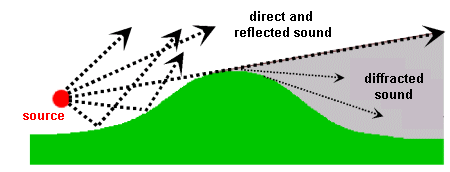
Diffraction into an acoustical shadow behind a hill
The Figure below shows the noise barrier constructed on side of roads to avoid traffic noise from disturbing tenants and dwellers in buildings and houses nearby. Although building a noise barrier, the noise is not totally omitted. This kind of phenomenon with sound coming around from behind is called “Sound diffraction”. The barrier can effective minimize noise that has high frequency with short wavelength but not low frequency sound. This is because low frequency has long sound wavelength that can bend into the sound shade area.
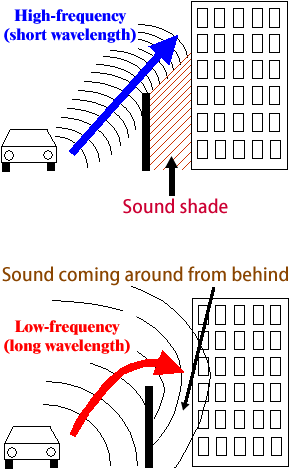
D. Sound Transmission
Noise is transferred into buildings and between parts of building by two main mechanism:
